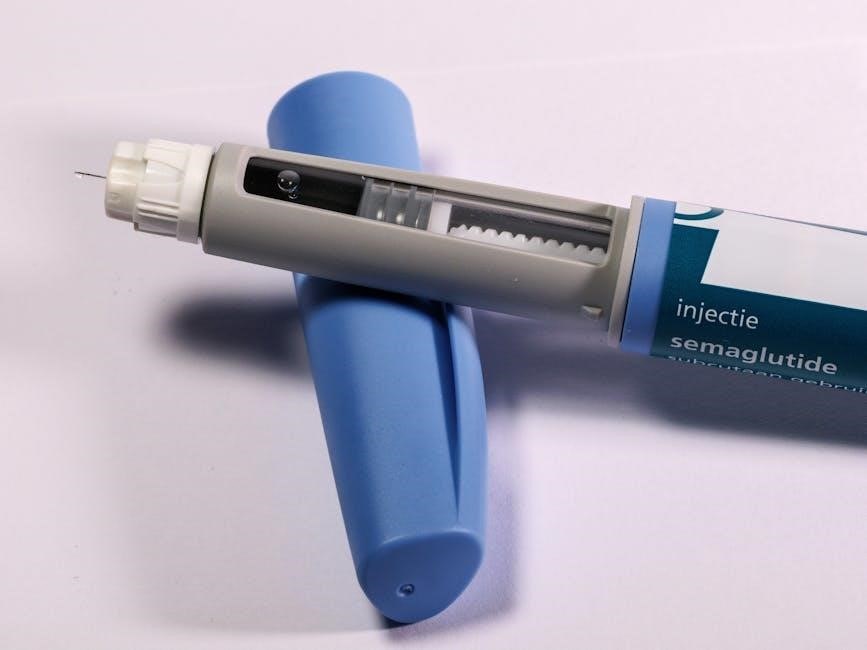An insulin chart is a comprehensive tool for diabetes management, providing guidance on insulin dosing, types, and timing. It helps individuals and healthcare providers track blood glucose levels, insulin requirements, and treatment plans effectively.
What is an Insulin Chart?
An insulin chart is a detailed guide outlining insulin dosages, timing, and types for individuals with diabetes. It helps manage blood glucose levels by providing structured plans for basal and bolus insulin administration. The chart typically includes target blood glucose ranges, correction doses, and meal-related adjustments. It serves as a reference for healthcare providers and patients to ensure safe and effective insulin therapy. Customizable to individual needs, insulin charts are essential for maintaining proper glucose control and preventing complications. They often include sliding scale insulin recommendations and specific dosing algorithms based on blood sugar monitoring results.
Why is an Insulin Chart Important?
An insulin chart is crucial for effective diabetes management, ensuring personalized treatment plans are clear and actionable. It helps prevent complications by maintaining target blood glucose levels, reducing the risk of hypoglycemia, and optimizing insulin dosing. By standardizing insulin administration, it minimizes errors and improves glycemic control. Healthcare providers rely on these charts to adjust treatments based on blood sugar monitoring and patient-specific needs. Patients also benefit from the clarity and structure, enabling better adherence to their care plans. Overall, an insulin chart is a vital tool for achieving long-term diabetes management goals and enhancing quality of life for individuals with diabetes.

Types of Insulin
Insulin is categorized into rapid-, short-, intermediate-, and long-acting types, each with distinct onset, peak, and duration profiles. These variations help tailor treatment to individual needs.
Rapid-Acting Insulin
Rapid-acting insulin begins working within 10-20 minutes, peaks in 1-3 hours, and lasts 3-5 hours. Examples include insulin aspart (NovoRapid) and insulin lispro (Humalog). It is ideal for mealtime dosing to control blood glucose spikes after eating. This type is often used in insulin pumps and pens for precise dosing. Its quick onset makes it effective for correcting high blood sugar levels before meals; Proper timing is crucial to avoid hypoglycemia. Users should monitor blood glucose levels closely to adjust doses safely and maintain target ranges.
Short-Acting Insulin
Short-acting insulin, such as Humulin R and Novolin, begins working within 30 minutes, peaks in 2-4 hours, and lasts 6-8 hours. It is often used for basal insulin needs and mealtime coverage. This type is commonly administered before meals to manage postprandial glucose spikes. Proper dosing and timing are essential to avoid hypoglycemia. Users should consult an insulin chart to determine appropriate doses based on blood glucose levels and meal plans. Regular monitoring is recommended to adjust doses safely and maintain target blood glucose ranges. Short-acting insulin is a reliable option for managing diabetes when used correctly as part of a structured treatment plan.
Intermediate-Acting Insulin
Intermediate-acting insulin, such as NPH (e.g., Humulin N, Novolin N), begins working in 1-2 hours, peaks between 4-12 hours, and lasts 12-18 hours. It is commonly used to provide basal insulin coverage between meals and overnight. This type is often combined with short- or rapid-acting insulin for mealtime glucose control. Dosage adjustments should be made based on blood glucose monitoring and insulin charts to avoid hypoglycemia. Intermediate-acting insulin is typically administered once or twice daily, depending on individual needs. Proper timing and dosing are crucial for effective glucose management and should be guided by a healthcare provider or insulin management plan.
Long-Acting Insulin
Long-acting insulin, such as glargine (e.g., Lantus, Toujeo) and detemir (Levemir), provides a steady basal insulin supply, mimicking natural pancreatic secretion. It begins working within 1-2 hours, has a flat, peakless profile, and lasts 20-42 hours. This consistency reduces hypoglycemia risk, especially at night. Long-acting insulin is typically administered once or twice daily, depending on the formulation. Dosage adjustments are based on fasting blood glucose levels and overall glucose trends. These insulins are ideal for patients requiring stable basal coverage and are often used in combination with short- or rapid-acting insulins for mealtime glucose control, as outlined in insulin charts.

Insulin Dosing Guidelines
Insulin dosing guidelines provide a framework for calculating initial doses, typically starting with 0.3-0.5 units/kg total daily insulin, distributed as basal and bolus doses. Adjustments based on blood glucose levels and mealtime needs ensure personalized therapy, promoting glycemic control and minimizing risks. Always consult a healthcare provider before making changes.
Basal Insulin Dosing
Basal insulin dosing focuses on providing a steady, background insulin level throughout the day, typically administered once or twice daily. The dose is often calculated as 40% of the total daily insulin dose. For example, if the total daily insulin is 40 units, 16 units would be basal. Long-acting insulins like glargine or detemir are commonly used. The dose should be adjusted based on fasting blood glucose levels, aiming for a target range of 70-110 mg/dL. It’s crucial to avoid hypoglycemia and ensure consistent glucose control overnight and between meals. Always titrate doses under medical supervision to achieve optimal results.
Bolus Insulin Dosing
Bolus insulin dosing is designed to manage blood glucose spikes after meals. It is typically administered before eating and uses rapid-acting insulins like aspart or lispro. The dose is calculated based on the carbohydrate content of the meal, blood glucose levels, and insulin sensitivity. A common approach is to allocate 20% of the total daily insulin dose for meal-related boluses. For example, if the total daily dose is 40 units, 8 units may be allocated for meals. Adjustments are made to achieve target blood glucose levels, ensuring proper glucose control without causing hypoglycemia. Always consult a healthcare provider for precise calculations.
Sliding Scale Insulin
Sliding scale insulin therapy adjusts doses based on blood glucose levels, typically before meals. It uses rapid-acting insulin like aspart or lispro. Blood glucose targets are usually 4-7 mmol/L. If levels are below 4, hypoglycemia treatment is needed. For levels 120-150 mg/dL, 2 units are given, increasing by 2 units for every 50 mg/dL rise, up to 351 mg/dL requiring 12 units. Above 351 mg/dL, 14 units are administered. This approach helps maintain tight glucose control and is often used in hospital settings or for short-term glucose management. Always consult a healthcare provider for safe and effective dosing adjustments.

Monitoring Blood Glucose Levels
Regular blood glucose checks are crucial for managing diabetes. Target levels are typically 4-7 mmol/L before meals and at bedtime. Monitoring helps adjust insulin doses and prevents complications.
Target Blood Glucose Ranges
Target blood glucose ranges are essential for diabetes management. For most individuals, fasting blood glucose should be between 4-7 mmol/L, while postprandial levels should be less than 10 mmol/L. HbA1c goals are typically below 7% for many patients. These targets help guide insulin dosing adjustments and prevent complications. Monitoring blood glucose levels regularly ensures that these goals are met. Keeping a glucose log can help track patterns and make informed decisions. Adjustments to insulin doses should be made under medical supervision to avoid hypoglycemia or hyperglycemia. Consistently meeting these targets supports long-term health and reduces the risk of diabetes-related complications.
Frequency of Monitoring
Regular blood glucose monitoring is crucial for effective diabetes management. Most individuals with diabetes should check their blood glucose levels at least four times a day: before meals, after meals, at bedtime, and occasionally during the night if needed. Those using intensive insulin therapy or with labile diabetes may require more frequent monitoring. Consistent monitoring helps identify patterns and trends, enabling timely adjustments to insulin doses or lifestyle habits. Maintaining a glucose log can also provide valuable insights for healthcare providers to optimize treatment plans. Proper monitoring frequency ensures better glycemic control and reduces the risk of complications.

Adjusting Insulin Dosage
Insulin doses are adjusted based on blood glucose levels, weight, and lifestyle factors. Adjustments are made gradually, typically every 1-2 weeks, to avoid hypoglycemia and achieve target glucose levels.
Factors Affecting Insulin Dosage
Several factors influence insulin dosage, including blood glucose levels, weight, meal composition, physical activity, and individual health conditions. Blood glucose levels before meals and bedtime guide adjustments. Weight plays a role in calculating total daily insulin needs. Meal size and carbohydrate content affect bolus doses, while physical activity may reduce insulin requirements. Health conditions like kidney disease or hormonal changes can also impact dosage. Additionally, insulin sensitivity varies among individuals, influencing how much insulin is needed. These factors must be considered to tailor insulin regimens effectively and maintain optimal glucose control.
How to Adjust Doses Safely
Adjusting insulin doses safely requires careful monitoring and gradual changes. Start by reviewing blood glucose logs to identify patterns. Increase or decrease doses by small increments, such as 2-4 units weekly, to avoid hypoglycemia. For basal insulin, adjust based on fasting glucose levels, while bolus doses should be tweaked according to pre-meal readings and carbohydrate intake. Always consult a healthcare provider before making significant changes. Regular follow-ups ensure adjustments are effective and safe, preventing complications like hypoglycemia or hyperglycemia. Patience and precision are key to maintaining glucose balance without risking adverse effects.

Insulin Delivery Devices
Insulin pens and insulin pumps are popular delivery options. Pens offer convenience with prefilled cartridges, while pumps provide continuous basal and bolus doses, enhancing precise glucose control and flexibility.
Insulin Pens
Insulin pens are portable, easy-to-use devices prefilled with insulin, offering precise dosing. They are convenient for managing blood glucose levels, especially for those with busy lifestyles. Pens like Novorapid, Fiasp, and Humulin R are widely used, with some models allowing preset doses. They are often preferred for their discreetness and ease of administration. Proper storage is essential, with most pens requiring refrigeration until opened, after which they can be stored at room temperature for a limited period. Insulin pens are a popular choice for their simplicity and effectiveness in diabetes care.
Insulin Pumps
Insulin pumps are small, wearable devices that deliver continuous insulin basal rates and bolus doses. They are ideal for precise glucose control, offering customizable dosing to match individual needs. Pumps like Medtronic, Tandem, and Omnipod provide tubeless or tubed options, integrating with glucose monitors for automated adjustments. They are particularly beneficial for those with type 1 diabetes or insulin-dependent type 2 diabetes, reducing the need for injections. Proper training is essential for safe use, and regular monitoring ensures optimal performance. Insulin pumps enhance flexibility and lifestyle adaptability, making them a preferred choice for many managing diabetes effectively.

Safety Precautions
Preventing hypoglycemia is crucial by monitoring blood glucose levels and adjusting insulin doses. Proper insulin storage ensures potency, and devices should never be shared to avoid infection risks.
Preventing Hypoglycemia
Preventing hypoglycemia involves regular blood glucose monitoring and adjusting insulin doses; Recognize symptoms like sweating, dizziness, or confusion and act promptly. Always carry fast-acting carbohydrates, such as glucose tablets or juice, for emergency treatment. Proper education on insulin dosing and timing is essential to avoid low blood sugar episodes. Healthcare providers should tailor prevention strategies based on individual risk factors and lifestyle. Monitoring blood glucose levels before meals and bedtime helps identify patterns that may lead to hypoglycemia, enabling proactive adjustments to insulin therapy.
Proper Storage of Insulin
Proper storage of insulin is crucial to maintain its effectiveness. Insulin should be stored in the refrigerator at a temperature between 2°C and 8°C until the expiration date. Once opened, some insulins can be kept at room temperature (up to 25°C) for a specific duration, typically up to 28 days. Always check the manufacturer’s guidelines for storage conditions. Avoid freezing insulin or exposing it to extreme heat or light. Use insulin vials or pens within the recommended timeframe after opening. Never use expired insulin, as its potency may be reduced. Proper storage ensures optimal glucose control and prevents waste.
